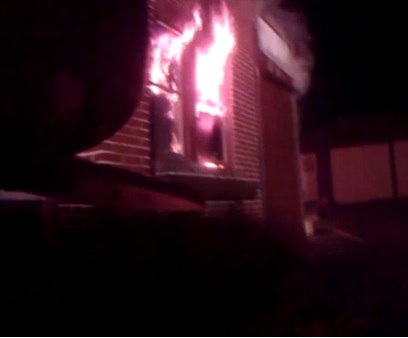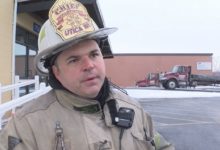UPDATED – DC internal affairs report shows key facts left out of Quander report on failure to help dying man
Click here if video above fails to play
More fire news from FireCritic.com
Read Statter report on Quander report
Read Quander report on Mills Case
Read excerpt from DC Fire & EMS Department internal affairs report
UPDATED Thursday 10:45 p.m.
Washington Post reporter Amy Brittain, who did the recent investigation into the DC Fire & EMS Department’s high school cadet program, talked briefly Thursday with Remy Jones. Jones is the probationary firefighter who had the first contact on January 25 with those seeking help for Cecil Mills. Jones became a firefighter as a recent graduate of the cadet program.
The internal affairs report obtained by WTTG-TV/FOX 5 reporter Paul Wagner shows that Jones admitted he did not know how to respond properly to the emergency. Jones failed to hit the bells to alert the crew of Truck 15 about the man down across the street. As I pointed out on Sunday, this key information and the procedure Jones failed to follow were omitted from the report released Friday by Deputy Mayor for Public Safety and Justice Paul Quander.
Here’s an excerpt from Brittain’s article:
Reached by phone late Thursday night, Jones referred questions to the fire department’s internal affairs unit, saying he would “get in trouble” if he spoke about his actions. He also criticized the Post for continuing to report on the incident.
“Every day is a new day,” he said. “I don’t understand why there is public interest in this. Why haven’t you found a new story?”
Jones said he has become “emotionally disturbed” because of the media’s calls and visits to his family’s home.
“I am a firefighter,” he said. “I have duties.”
EARLIER
If you read my analysis of Paul Quander’s report into the death of Cecil Mills posted Sunday night, you probably came away with the impression I thought the deputy mayor’s investigation was a sham. That would be accurate.
My take on the report was not based on any sources or inside information, but only on the reading the report, my knowledge of how the DC Fire and EMS Department operates and the public record of the last three years. I focused on what is not in the report.
Mayor Vincent Gray praises report, Dep. Mayor Quander & Chief Ellerbe
The key thing missing was any discussion of what the probationary firefighter should have done when citizens came to the firehouse seeking help after Mr. Mills collapsed at the shopping center across the street from the quarters of Truck 15. Quander never mentioned that the probie didn’t ring the bells to turn out Truck 15 and never offered an explanation for those actions. That alone made the report pretty worthless and Quander’s motives quite suspect.
Today we have some answers. WTTG-TV/FOX 5 reporter Paul Wagner uncovered the department’s internal affairs report into the incident (watch the video above). It has all of the details that were missing about the probie’s actions and a lot more that was left out of the Quander report. Significant and important facts that were omitted. As I wrote Sunday, Paul Quander’s report was just a diversion and worked hard to shift focus away from Chief Kenneth Ellerbe.
As I suggested it might, the training of the probie is a key element in what happened on January 25. It is clear in his own statement that is part of the internal affairs report, the probie didn’t know how to handle the situation. The probationary firefighter’s training came though the department’s high school cadet program (something also left out of the report). The program is a priority initiative of Chief Ellerbe’s administration.
The internal affairs report also points out the admission by Truck 15’s lieutenant that she lied in her initial statement about the incident. The IA report also looks at how the 911 center failed to dispatch Truck 15 to the call across from the firehouse. These are both significant omissions from the Quander report.
Yesterday Mayor Vincent Gray spoke highly of Paul Quander’s report and the cadet program. Seems to me the internal affairs report shows that the mayor either had no clue of what he was talking about or he is in on Paul Quander’s efforts to keep us in the dark about what really happened when Cecil Mills needed help.
A report released earlier this week on the January death of Cecil Mills is missing key information on what happened the day he collapsed across the street from a firehouse.
An internal affairs report obtained by FOX 5 shows there are glaring omissions in the report written by the deputy mayor for public safety and released to the public last Friday.
Examples include:
– The rookie firefighter says he was not trained properly and was afraid to take action.
– The lieutenant in charge of the truck that day lied in her initial report.
– The dispatchers should have known Truck 15 was available for service, but was never put on the call.
Let’s start with the rookie who told investigators “he didn’t know what to do.”
In the internal affairs report, Remy Jones, who is only 19 years old, told investigators he had never been trained on what to do when someone came to the firehouse looking for help.
He also said he wanted to run across the street to help Mills, but was afraid of leaving the truck a person short and would therefore get in trouble. Being a rookie, he could then lose his job.
Jones also told investigators he didn’t ring the bells in the firehouse, a routine action whenever there is an emergency, because he thought they could only be rung at night.
None of that was included in the Paul Quander report.
Now onto Lieutenant Kellene Davis. Did she lie?
According to the internal affairs report, she did. In her initial statement, she said she “proceeded outside of quarters (meaning the firehouse) to investigate” after being told of what was happening across the street.
It turns out she admits she never left the building. Lt. Davis also told investigators she did not need an exact address even though she said so in her initial statement.
At the end of the interview, Lt. Davis told investigators, “on this job sometimes mistakes are made, it happens.”
And finally — Truck 15 in that same firehouse — was recommended to respond, but was not dispatched. That part is brand new, and again, not included in the public report released by Deputy Mayor Quander.
Why didn’t dispatchers at the 911 center put Truck 15 on the call?
The report says the computer-aided dispatch noted Truck 15 was in service and in quarters across the street from the incident and recommended the truck be placed on the call three different times, but it never happened.
Why? We don’t know. That part is not explained.
Statements from the firefighters’ union:
The DC Fire Fighters Association IAFF 36 has had serious concerns about the integrity of this investigation from the start. In a letter to Council member Wells dated February 12, 2014 we stated “The fire department is no longer capable of undertaking this investigation in a fair and impartial manner.” I restated the same before before the Council on February 24, 2014 :”We want to answer the “Why” question that the public has demanded. We want to make every effort possible to restore public confidence, which we hold so dearly.”
Any omissions between the internal report and the final report further damages that confidence for both the the family and the citizens we serve. We need answers to these disturbing questions.
Edward C. Smith
President
IAFF Local No. 36
DC Fire Fighters AssociationStatement from Keith Saint Clair, spokesperson for the Deputy Mayor for Public Safety and Justice Paul Quander:
A copy of the internal affairs investigation was provided to one of the FEMS members involved so that member could prepare for an upcoming trial board action.
An internal affairs report is just that: internal. Some of the details in a lengthy agency report were not included by Deputy Mayor Quander in his public report of his investigation into Medric Mills’ death. Like any plaintiff or prosecutor, not all the details in a case are made public in advance of trial. Our approach to this matter has been meticulous and methodical. A balance must be struck between the dissemination of information to the public and the due process rights of employees.
We urge you to use caution, as well, so those who have blame are appropriately held accountable and that any imposed sanction is sustained upon appeal.








